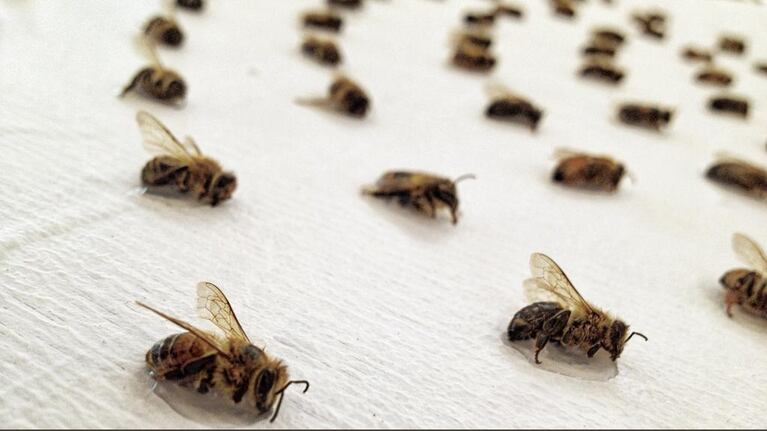
Artist Sarah Hatton has created a series of works using thousands of dead bees displayed in spirals symbolic of agriculture. She wants to bring attention to bees' decline due to pesticide use.
Pierre Laporte Photography
A headline at green blog Inhabitat mentioning "thousands of dead bees" and "dizzying mandalas" drew me in. The image that greeted me when I clicked through did not disappoint.
In an email, Canadian artist Sarah Hatton shared her inspiration for the series of works:
“I am a visual artist who also happens to be a beekeeper. Life often finds its way into one's art, and I had long been thinking of an artistic way to talk about the global decline of the bees. I decided to use dead bees as the most direct visual way to represent this message, with the most emotional impact," Hatton wrote.”
Sarah Hatton's 'Circle 2.'
Credit: Pierre Laporte Photography
The bees used in Hatton's art work actually came from two of her own hives, which died from natural causes.
Hatton says she chose patterns that "have symbolic ties to agriculture." And further, the "dizzying" effect of the patterns is meant to reflect the effect of neonicotinoid pesticides, which Hatton says, "destroy bees' navigational systems."
If you happen to be in or near Ottawa, Canada, you can see Hatton's "Bee Work" in person at a one-night showing December 4.
Just this week, Oregon's Department of Agriculture announced they will restrict use of pesticides containing two specific neonicotinoids. The action is in response to die-offs this summer that killed more than 50,000 bees.
Another more artistic response to the Oregon bee die-offs comes from Portland poet and visual artist Pattie Palmer Baker. She said that the news of the bee deaths haunted her.
"I thought about how it looked. It made me see it visually," Baker told me.
The event prompted a poem which she exhibited as part of a recent gallery show in Portland. Though Baker’s art work typically combines paste paper collage and calligraphy, for now the words stand alone. Baker intends to evolve the work to include the visuals soon.
Here's the full poem:
50,000 BUMBLEBEES DIE
The sprayer is only following orders.
He masks-up,
power-mists poison cloudsover the Linden trees,
speeds off in his red pickup truck.
Fifty thousand bumblebees down-draft
and soft-plop on the once ashen asphalt –
now a black gold-flecked Persian carpet.
Some are dead before they hit the ground,
others jerk their wings, scrabble their tiny legs
struggling to lift-off and carry home
their nectar-pollen load.
The sweepers are only following orders.
They crunch the bumble bees under their work boots,
shovel the dead and dying into black plastic bags,
speak of their surprise at the lightness of so great a bulk.
Nearby the colonies hunker in small ground holes,
larvae pheromone their hunger,
queens and drones whisper confusion
and wait.
No workers,
not one floats down the hollowed passage ways.
Buzzless silence sags into the day after
and all the queens dream
of fuzzed carapaces tumbling onto a funeral pyre,
exploding yellow ebony-banded flames
higher than the Linden trees.
The grieving queens follow the curl
of amber-streaked smoke
fly into the fire's hot center,
shoot out gold-barbed fireworks
stinging the onlookers blind.
-- Toni Tabora-Roberts


